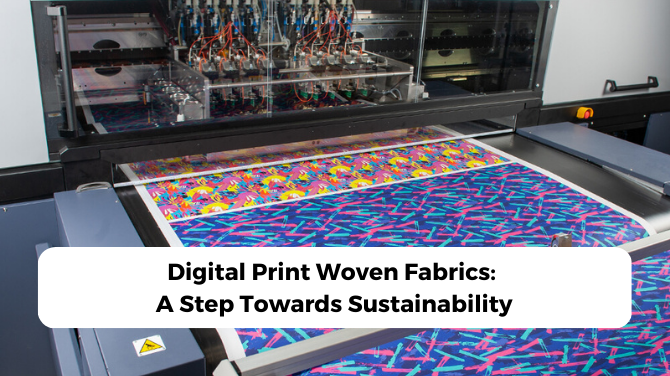As the world is becoming more conscious about the environment, the fashion industry is also shifting its focus towards sustainable practices. The textile industry, which is one of the largest polluters globally, is now adopting various measures to reduce its carbon footprint. One of the significant steps taken by the industry is the use of digital print woven fabrics. In this article, we will discuss how digital print woven fabrics are a step towards sustainability.
In recent years, there has been a growing demand for sustainable fashion. The fashion industry is moving towards sustainability by adopting various eco-friendly practices. One of the significant challenges that the textile industry faces is the environmental impact of textile production. The use of digital print woven fabrics is a sustainable solution that the industry has adopted to reduce its carbon footprint.
What are Digital Print Woven Fabrics?
These are textiles that are produced using digital printing technology. Unlike traditional printing methods, which use screens and stencils, digital printing is a process where the design is directly printed on the fabric using a digital printer. This process allows for greater precision and accuracy in printing, and it is also more environmentally friendly.
Watch how Kontoor brands are reducing water waste by digital printing vintage denims
Benefits of Digital Print Woven Fabrics
- Reduced Waste
These types of fabrics produce less waste than traditional printing methods. In traditional printing, excess ink is often left on the screen or stencil, leading to more ink being used and more waste being produced. Digital printing, on the other hand, uses only the amount of ink that is necessary, resulting in less waste.
- Water Conservation
The traditional textile printing process requires a lot of water, which can lead to water pollution and scarcity. Digital printing, on the other hand, uses less water, reducing the environmental impact of textile production.
- Energy Efficiency
Digital printing is an energy-efficient process as it requires less energy to produce the same amount of printed fabric than traditional printing methods. The ink used in digital printing also dries faster, reducing the amount of energy required for drying.
- Flexibility in Design
Digital printing allows for greater flexibility in design, as it can print intricate patterns and designs that are difficult to achieve with traditional printing methods. This flexibility also leads to less waste, as designs can be printed on demand, reducing the need for excess inventory.
- Reduced Carbon Footprint
The use of these types of fabrics reduces the carbon footprint of the textile industry. The reduction in waste, water consumption, and energy usage all contribute to a more sustainable production process.
Also read: Merchandisers Guide to Determining the EPI and PPI of Fabric
Challenges of Digital Print Woven Fabrics
Despite the benefits of digital print woven fabrics, there are some challenges that the textile industry faces while adopting this technology.
- High Initial Cost
The initial cost of setting up a digital printing facility is relatively high compared to traditional printing methods. This cost can be a barrier for small and medium-sized textile businesses.
- Limited Availability of Materials
These types of fabrics require special types of fabric and ink, which are not readily available. This limited availability can make it difficult for businesses to switch to digital printing.
- Quality Concerns
Some experts have raised concerns about the quality of digital print woven fabrics compared to traditional printing methods. However, as technology continues to improve, these concerns are being addressed.
Conclusion
Digital print woven fabrics are a sustainable solution that the textile industry has adopted to reduce its environmental impact. This technology offers numerous benefits, including reduced waste, water conservation, energy efficiency, flexibility in design, and reduced carbon footprint. Although there are some challenges, the industry is continuously working towards improving the technology to make it more accessible and sustainable.
If you are looking for a reliable woven fabric manufacturer, please contact us.
FAQs
- How are digital print woven fabrics eco-friendly?
They are eco-friendly as they require less water, energy, and produce less waste than traditional printing methods. This makes them a more sustainable option for textile production.
- Are digital print woven fabrics more expensive than traditional fabrics?
The initial cost of setting up a digital printing facility is relatively high compared to traditional printing methods. However, in the long run, digital printing can be more cost-effective as it reduces waste and excess inventory.
- How do digital print woven fabrics contribute to reducing the carbon footprint?
These types of fabrics use less water, energy, and produce less waste than traditional printing methods. This reduction in resource consumption contributes to reducing the carbon footprint of the textile industry.
- What types of fabric can be used for digital printing?
Digital printing requires special types of fabric that are suitable for the printing process. Polyester, silk, and cotton are commonly used for digital printing.
- How can small and medium-sized textile businesses adopt digital printing?
The high initial cost of setting up a digital printing facility can be a barrier for small and medium-sized textile businesses. However, there are options for outsourcing digital printing to specialized facilities that can make it more accessible for businesses of all sizes.











